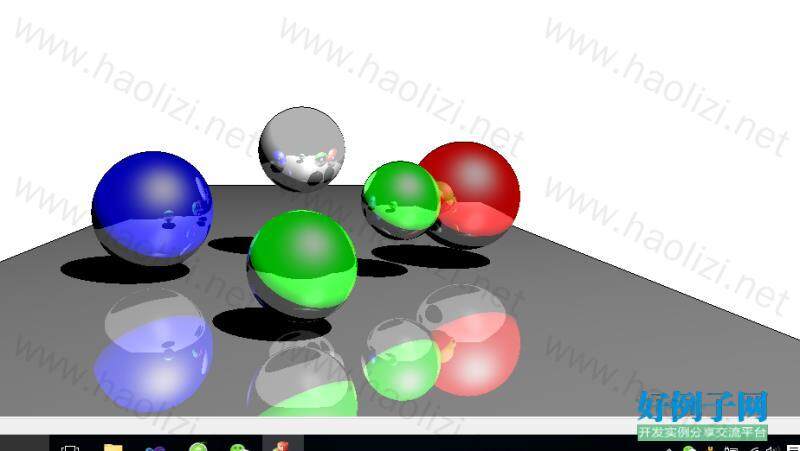实例介绍
【实例简介】c MFC算法实现光线跟踪算法,将光线从人眼的方向开始跟踪,直至光线消失
【实例截图】
【核心代码】
void CTestView::DrawObject(CDC* pDC)
{
objects[0] = new CSphere(60,CP3(-150,-70,-100),pMaterial[2]);//获取球的半径,位置,材质
objects[1] = new CSphere(40,CP3(0,-90,100),pMaterial[0]);//获取球的半径,位置,材质
objects[2] = new CSphere(60,CP3(180,-60,-170),pMaterial[1]);//获取球的半径,位置,材质
objects[3] = new CSphere(50,CP3(0,-10,-200),pMaterial[3]);//获取球的半径,位置,材质
objects[4] = new CSphere(40,CP3(100,-60,-100),pMaterial[0]);//获取球的半径,位置,材质
objects[5] = new CPlane(140,CP3(0.0,1.0,0.0),pMaterial[4],-350,350,-140,-140,-1600,300);//下面的墙
nObjectCount = 6;
for (int i = -Width/2; i< Width/2; i )//遍历背景
{
for (int j = -Height/2; j< Height/2; j )
{
is_pppp = true;
CVector EyeToScreenP(projection.ViewPoint,CP3(i,j,-200)); //从屏幕到 某一视点 像素中心得 矢量
CRay ray(projection.ViewPoint,EyeToScreenP); //光线的 起点, 方向矢量
ray.alpha = -1;
ray.Normalized(); //单位化该矢量
CRGB color = Trace(ray,3); //发出这条矢量
CP2 p = projection.PerspectiveProjection(ppppp);//透视投影
color.Normalize();
pDC->SetPixelV(Round(p.x),Round(p.y),RGB(color.red,color.green,color.blue));
}
}
}
CRGB CTestView::Trace(CRay ray, int count) // 从视点 发出的 第一条 矢量 、 递归次数
{
CRGB ret(0.0,0.0,0.0); //初始 颜色 、黑色
if(!count)//递归次数为3
{
return ret;
}
CInterPoint min_hit;
for (int i = 0; i<nObjectCount; i )// 循环所有物体,找到 最先与此条光线相交 的一点
{
CInterPoint hit;
if (objects[i]->GetInterPoint(ray,hit) && hit.t > 0.00001 &&hit.t < min_hit.t)
{
min_hit = hit; //找到最近的交点保存
}
}
if (min_hit.t == 100000) //没有找到
{
return ret;
}
else
{
if (is_pppp)//保存每一次刚开始的交点坐标,让其透视投影
{
ppppp = min_hit.IntersectionPoint;
}
is_pppp = FALSE;
return Shade(ray, min_hit, count); //找到了光线与物体的第一个交点min_hit
}
}
CRGB CTestView::Shade(CRay ray, CInterPoint hit, int count)//此条光线矢量 交点 递归次数
{
CRGB ret(0.0,0.0,0.0);
CP3 point = hit.IntersectionPoint; //光线与物体的交点
for (int i = 0; i < nLightCount; i )
{
CRay shadow_ray(point, CVector(point,pLight->Light[i].L_Position)); //交点到 光源的 光线
shadow_ray.Normalized();//方向单位化
CInterPoint min_hit;
for (int j = 0; j<nObjectCount; j )//判断在 交点和 光源之间是否有物体阻挡
{
CInterPoint hit1;
if (objects[j]->GetInterPoint(shadow_ray, hit1) && hit1.t > 0.00001 && hit1.t < min_hit.t)
{
min_hit = hit1;
}
}
//交点与光源的距离
double dist = sqrt(pow(pLight->Light[i].L_Position.x-point.x,2)
pow(pLight->Light[i].L_Position.y-point.y,2)
pow(pLight->Light[i].L_Position.z-point.z,2) );
if (min_hit.t >= dist)
{
ret = pLight->Lighting(ray.origin ,point, hit.Nformal,&hit.pMaterial, i);
}
else
{
ret = CRGB(0.2,0.2,0.2);
}
}
///////////
////加入递归
CRGB TotalRGB ;
CRGB s = Trace(CalculateReflection(ray, hit), count - 1); //反射
TotalRGB = 0.6 * s 0.7 * ret ;
// TotalRGB = ret;
return TotalRGB;
}
CRay CTestView::CalculateReflection(CRay in, CInterPoint hit) //已知入射光线 和交点 求反射 光线
{
CRay ret;
CVector VL(-in.dir.x, -in.dir.y, -in.dir.z);//单位化之后的入射光线矢量
CVector VN(hit.Nformal.x, hit.Nformal.y, hit.Nformal.z);//交点法向量矢量
VN = VN.Normalize();//单位化
CVector R = 2.0 * VN * fabs(DotProduct(VN, VL)) - VL;
ret.dir.x = R.x;
ret.dir.y = R.y;
ret.dir.z = R.z;//新光线的方向矢量
ret.origin = hit.IntersectionPoint;//新光线的起始点
ret.Normalized();
return ret;
}
好例子网口号:伸出你的我的手 — 分享!
小贴士
感谢您为本站写下的评论,您的评论对其它用户来说具有重要的参考价值,所以请认真填写。
- 类似“顶”、“沙发”之类没有营养的文字,对勤劳贡献的楼主来说是令人沮丧的反馈信息。
- 相信您也不想看到一排文字/表情墙,所以请不要反馈意义不大的重复字符,也请尽量不要纯表情的回复。
- 提问之前请再仔细看一遍楼主的说明,或许是您遗漏了。
- 请勿到处挖坑绊人、招贴广告。既占空间让人厌烦,又没人会搭理,于人于己都无利。
关于好例子网
本站旨在为广大IT学习爱好者提供一个非营利性互相学习交流分享平台。本站所有资源都可以被免费获取学习研究。本站资源来自网友分享,对搜索内容的合法性不具有预见性、识别性、控制性,仅供学习研究,请务必在下载后24小时内给予删除,不得用于其他任何用途,否则后果自负。基于互联网的特殊性,平台无法对用户传输的作品、信息、内容的权属或合法性、安全性、合规性、真实性、科学性、完整权、有效性等进行实质审查;无论平台是否已进行审查,用户均应自行承担因其传输的作品、信息、内容而可能或已经产生的侵权或权属纠纷等法律责任。本站所有资源不代表本站的观点或立场,基于网友分享,根据中国法律《信息网络传播权保护条例》第二十二与二十三条之规定,若资源存在侵权或相关问题请联系本站客服人员,点此联系我们。关于更多版权及免责申明参见 版权及免责申明



网友评论
我要评论